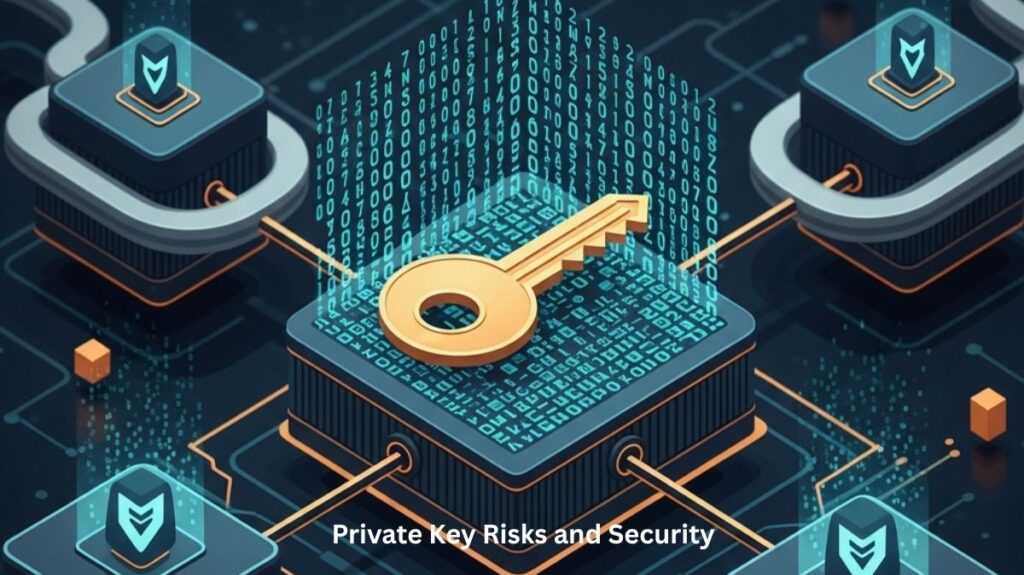The nature and definition of private keys, their relationship to public keys and addresses, their usability and functionality, the private key risks and security, and storage problems are all covered in this blog.
Private key in blockchain

In blockchain technology, a private key is a secret alphanumeric code that gives you total ownership and control over your cryptocurrency or other digital assets. It is an essential and confidential element that supports digital asset ownership and security.
Nature and Definition
- In essence, a private key is a lengthy, randomly selected binary number, usually 256 bits in length. It is typically shown in hexadecimal format for practical reasons.
- It is a hidden string of characters and numbers that resembles an extremely complicated password. It signifies your ownership of a digital asset and serves as a digital signature.
- It can be compared as the “password” that lets you access your digital wallet and communicate with the blockchain. It is similar to a bank card PIN in that it needs to be kept confidential in order to approve transactions.
Relationship with Public Keys and Addresses
- In Public Key Cryptography (PKC), a private key is an essential component of a cryptographic key pair that also includes a public key.
- Using a specialized procedure such as the Elliptic Curve Digital Signature procedure (ECDSA), your private key is mathematically converted into a unique public key.
- The public key is then used to generate a shorter, alphanumeric string known as the public wallet address, frequently with the use of a cryptographic hash function.
- The procedure of this derivation is one-way. Although it is nearly difficult to reverse-engineer the private key from the public key or address, you can always generate a public key from a private key (and an address from a public key).
- Your private key is the PIN or signature you use to approve transactions, while your public key is your bank account number. A mailbox address (public address) and its key (private key) can be compared in another way. While anybody can send mail to the address, only the owner who has the key can access the contents.
Usability and Functionality
- Digital Signing and Authorisation: Digital transaction signing is the main application for a private key. Your wallet software utilises your private key to “digitally sign” transactions when you want to send cryptocurrency. This signature attests to the fact that you alone are the owner of the money and possess the power to transfer it. Without seeing your private key, the blockchain network can then validate the signature using your public key. Since any modification will result in an inaccurate signature, the signature guarantees that the transaction cannot be altered once it has been broadcast.
- Access and Asset Management: You can access and manage any digital assets linked to that private key on the blockchain if you have it. It enables you to send, receive, and trade cryptocurrencies as well as manage your digital assets.
- Proof of Ownership: It acts as the appropriate cryptocurrency’s proof of ownership.
Private Key Risks and Security

- Essential Confidentiality: You must never divulge your private key to anybody. Anyone who has access to your private key can sign transactions on your behalf and take possession of the related assets, thus emptying your wallet.
- Irreversible Loss: You will never be able to access your money again if you misplace your private key. The identical key cannot be generated computationally.
- Theft: Your valuables could be taken if someone else manages to obtain your private key. Generally speaking, once money is moved on the blockchain, it cannot be reversed. The term “stolen cryptocurrency” in news reports nearly invariably refers to private keys that have been taken rather than a breach of the blockchain network itself.
- The maxim “not your keys, not your coin” emphasises how crucial self-control and appropriate key management are.
- Private keys are frequently generated from a “recovery seed” or “seed phrase” (a string of words) for convenience and backup purposes. This makes the key more recoverable and readable by humans; it is important to preserve this seed phrase safely.
Also Read About What Is A Desktop Wallet And How Does Desktop Wallets Work
Storage
- Digital “wallets,” which are interfaces for safely storing these cryptographic keys, are where private keys are kept. Since assets are kept on the blockchain, wallets do not really contain the cryptocurrency.
- Wallets can be hardware-based (physical devices) or software-based (such as desktop programs or mobile apps).
- Custodial wallets allow your private keys to be stored and managed by someone else (such as an exchange).
- You have complete control over your private keys with non-custodial wallets.
- Additionally, key storage can be classified as “cold” (offline) or “hot” (connected to the internet). Because of their decreased security concerns, cold wallets, and hardware wallets like the Ledger Nano X are regarded as a good way to protect keys without sacrificing convenience.
- To reduce the chance of theft or loss, it is essential to save your private key in a safe place, ideally offline. You can utilise gadgets made especially for storing them, or you can write or type them on paper (paper wallets).
Also Read About Wallet Vs Exchange: Difference Between Wallet And Exchange
